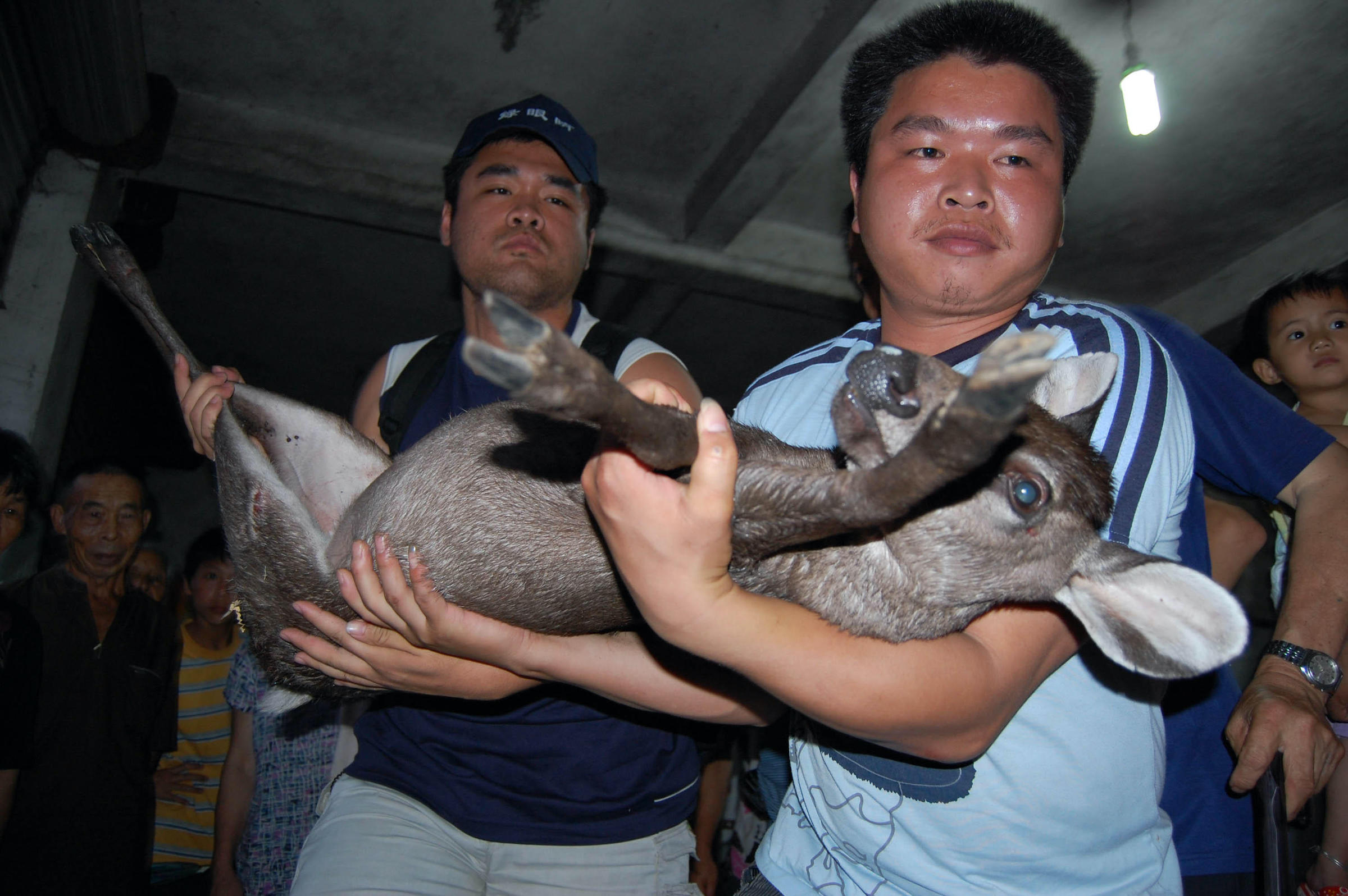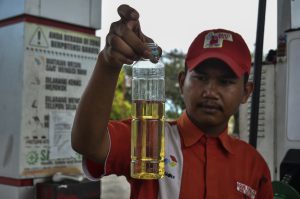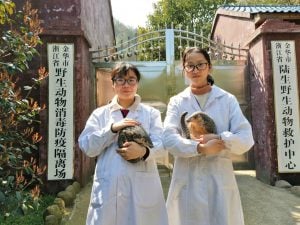It’s not yet light, but Mr Qiu of Foshan in Guangdong is busy transferring king ratsnakes from a cage into a sack. He then tips them into a boiling pot.
He’s been running his snake-soup shop for over a decade.
In winter, residents of Guangdong province, south China, pay particular attention to diet and nutrition, meaning the shop is constantly busy. A bowl of piping hot snake soup is a breakfast favourite for many locals looking to ward off the cold. “We Cantonese have always believed that snake meat can treat illnesses, plus its nutritious and keeps out the cold,” Qiu says.
The market for meat from wild animals is on the increase, with restaurants doing good – if under the table – business. Protected animals such as monitor lizards and pangolins are hunted and traded illegally, eventually ending up on diners’ plates.
The reputation the Cantonese have for eating wild animals is well-deserved: the long-standing tradition is a part of the culture in Lingnan (the area covering Guangdong and surrounding provinces). An employee with the Wildlife Conservation Society’s China office said that the Cantonese “will eat anything” – and the most sought-after delicacies are endangered species.
Among the most regularly eaten in Guangdong are: the pangolin, the monitor lizard, the giant salamander, wild snakes, owls and the yellow-breasted bunting. After preparation, an owl can be worth about 1,800 yuan. Pangolins sell for 500 yuan a jin, monitor lizards for about 100 yuan.
The murky restaurant trade
According to Yang Nan (a pseudonym), a member of the Nature Lovers Society who carried out a survey in Guangzhou, the yellow-breasted bunting may be the animal traded most frequently in the city’s markets.
The nutritional value of the bird has acquired almost mythical status in the past three decades. In season, 100,000 might be delivered to restaurants every day, each worth 100 yuan when made into soup. Huge flocks of these birds used to fly over Beijing in the spring and summer, but they have hardly been seen for the last decade – soon they will have all been eaten up. “Migratory birds all know to avoid Guangdong now,” says Yang.
Preparing such delicacies is a bloody business.
A chef from a restaurant in the Guangdong city of Shenzhen described how to butcher a pangolin: first, stun it with a hammer blow to the head, then hang it up from a rope and use a sharp knife to open its throat and drain the blood. Next, place it in boiling water to remove the scales – just like removing feathers from a chicken. Then use a low heat to remove the fine hairs. Finally, gut it, clean it and cook it. The meat can be braised, steamed in clear soup or stewed.
“Most of the frequent customers aren’t paying their own bills,” said one restaurant boss. “Businessmen who need a favour are taking them out for dinner, when they need to flash their cash, or show their respect for an official.” And it is government customers that are protecting restaurants selling illegal meats.
Zhang Yi (also a pseudonym) comes from one of those official’s families. She says that customers are all regulars, and to become a regular yourself requires an introduction. A stranger walking in and asking for these foods will get nowhere.
The actual cooking doesn’t usually take place at the restaurant. The restaurant boss will rent somewhere nearby – it might be a stove in a storeroom, or maybe a factory canteen kitchen. Orders are prepared there before being taken to the restaurant for any finishing touches and to be served.
See also: South China’s taste for wildlife
Medicinal power of wild animals
The Chinese passion for eating wild animals is tied up with the belief that foods can have medicinal properties. Ancient medical writings ascribe such uses to almost all plants and animals – even animal organs, excrement, bodily fluids and skin and feathers. Chinese medicine holds that medicine and food are of the same source. These views are still hugely influential, and even the virtually illiterate can name a number of “prescriptions” for various ailments: spirits made with tiger penis or sheep testicles for virility; or tiger bones for strong bones and muscles. And it is generally accepted that health is better maintained through diet than medicine.
But these ideas are becoming ever more extreme. Virtually all unusual or rare plants and animals are now endowed with incredible medicinal or nutritional properties.
So are these wild animals actually more nutritious?
Zheng Jianxian, a food scientist at South China University of Technology, thinks not: “These foods don’t have the mystic properties claimed. Comparing the nutritional values of domestic fowl and livestock with wild animals we found identical quantities of protein, carbohydrates, fats and other nutrients. There is no special nutritional value or particular benefit. And even if there are some minor differences, these are nowhere near as significant as people think.”
In many cases, such foods may in fact be less nutritious. Shark fin is made up of thin strips of cartilage and has no flavour of its own, nor special nutritional value. It mainly consists of collagen, an incomplete protein as it lacks the essential amino acids tryptophan and cysteine. It is much less nutritious than shark meat, which is a complete protein.
It’s a similar story with bird’s nest soup, seen by the Chinese as a nutritional treasure. This soup is made with the nest of the cave swift, containing the bird’s saliva, seaweed, feathers and plant fibre. The saliva itself contains enzymes, mucus proteins, carbohydrates and some salt. These are all found in the saliva of other animals – there is nothing magical here.
Yet these particular nests have become valuable commodities, supporting a supply chain stretching from collectors to processors to consumers. Cave swift populations on the coasts of south-east Asia face disaster due to hunting.
Feng Yongfeng, an environmental reporter at Guangming Daily, argues that most of the benefits are psychological. But that entrenched psychology is still resulting in the killing of wild animals.
Mr Luo, a resident we spoke to in Guangzhou, admits he eats these animals, and it would be a hard habit to change quickly. But he says the government should do more to publicise the ban on eating protected animals.”
“The government and media have encouraged people not to eat shark fin, tiger penis and bear paw, so I won’t eat them,” he says. But he says he ate pangolin for 10 years before he found out it was a protected animal, and the public should be clearly told what can and cannot be eaten.
The Vietnam and Myanmar supply chain
Guangdong might be where many of China’s wild animals are eaten, but it’s not where they come from.
The monitor lizards and pangolins in Guangdong’s markets come mostly from Vietnam and Myanmar, having been transported in via south China’s Guangxi and Yunnan provinces. Other animals are usually sourced from China’s Hubei province or the north-west. Birds of prey are caught in Gansu, Ningxia or Qinghai, while other birds are caught on the coasts of Jiangsu and Zhejiang in eastern China. Bear paws are brought in from Yunnan.
Li Yiming of the Chinese Academy of Sciences’ Institute of Zoology, studies the trade in wild animals on the China-Vietnam border. He says the economic gap between the two nations allow for huge profits to be made from smuggling illegal game.
Five Finger Mountain on Hainan island, south China, is home to numerous wild animals and has excellent transportation links. Combined with the rampant poaching industry, this makes it a major source of wild animals for Guangdong’s markets.
The king cobra is an extremely rare snake, in China surviving only in the virgin forests of the sub-tropics. But since just one of them sells for at least 2,000 yuan, the hunters are adept at finding them. After a quick sale, the snakes will likely be shifted to Guangzhou or Hong Kong.
The hunters also place traps where the virgin and secondary forests meet. Animals are often found here as they move between the abundant fruit in the virgin forest and hiding places in the denser secondary forest. The traps are simple, but no less dangerous.
The poachers often cut off an animal’s limbs before carrying it down the mountain. The head is of no use and is discarded.
They work after sunset, explains local resident Ah Mao: “They have guns stashed up on the mountain, and go up with torches to find them and hide, listening out for animals like the civet cats and the red giant flying squirrel – these animals drop fruit peel on the ground when they’re eating, so they’re easy to hear. The hunters listen out for this and use their torches to spot their prey. The animal’s eyes reflect the light, making them an easy target. The hunters hit their mark nine times out of 10.”
The catch is skinned and dried in front of a fire before being taken home to await collection. Once the merchant has a full load, he drives it to Haikou city, where someone else loads it onto a freighter, labelled as frozen meat bound for China’s biggest wild-animal meat market: Guangzhou.
Markets evade crackdown
The second link in this illegal trade takes place when the various products arrive in Guangzhou and are sold at markets.
Hu Shijia, an expert with the South China Wildlife Species Testing Centre, has been studying such markets since 2006. He says that tougher law enforcement has forced the traders underground, and that outsiders are unlikely to be aware of them.
According to Hu, the biggest market in the region is the Xingfu Wholesale Market, outside the city of Conghua, about 46 miles from Guangzhou city centre. This agricultural market sells all types of poultry and livestock. And on an undercover visit, many merchants were also found to be hawking civet meat. One stallholder said he had the meat in stock, at 110 yuan a jin.
In the snake section, live snakes writhe in cages and nets. When asked if they had pangolin, king cobras or the Chinese cobra, all some stallholders wanted to know was “how much do you want?”
A source with Guangzhou’s forestry police said the market is busiest between the early hours of the morning and 6am. Activity peaks at about 4am. Animals are brought in on trucks from other provinces, and taken to Guangzhou and the Pearl River Delta in vans and cars.
There used to be two major wild game markets nearer to Guangzhou. The one on Zengcha Road in the Baiyun district was once the largest in China, but is now in decline. The other was Qingfeng Food Market in nearby Foshan.
Xingfu Wholesale Market has now taken their place. But for years, new markets have been springing up following crackdowns elsewhere, and the actual trade continues unabated.
Nature reserves selling bushmeat
More worrying are the restaurants selling “bushmeat” next to national nature reserves, where food is going directly from the poachers to the kitchen.
The Southern Metropolis Daily has reported in the past that protected animals such as the silver pheasant, muntjac deer and the ring-necked pheasant were being openly butchered and killed in numerous restaurants around the Nanling National Forest Park, Guangdong’s largest national reserve. The Cabot’s tragopan, another type of pheasant, is subject to the highest level of state protection as there are only several thousand left. It was also being killed for food.
The local forestry police offices are only several hundred metres away from these restaurants.
Worse, even if these animals were saved, there is still a possibility they would end up back on the dinner table.
During our interviews, many diners said that animal rescue authorities and the forestry police actually poach the animals they are meant to protect. Animals released into the wild may later be caught for sale. Other animals might be trapped under the pretence of providing medical treatment and then smuggled off to the dinner table. Some reserve workers simply catch and sell their charges.
“It’s an open secret,” says an insider, Mr Li: many restaurants obtain their meat from animal protection centres. Media reports have accused the forestry police in one Pearl River Delta city of confiscating bear paws – and then taking the paws to a restaurant to eat.
Zou Ke of the Guangdong Wildlife Rescue Centre said that, under the rules, rescued animals will always be returned to the wild if possible. If an animal cannot be saved, it may be used as a specimen at zoos or research institutes, where it might be dissected or stuffed as an exhibit. Otherwise, the body will be sent to a waste disposal facility.
Wang Yingyong, deputy head and senior engineer at Sun Yat-Sen University’s Museum of Biology, said that the reserves often exist only in name and animal protection is failing.
Gong Shiping, a researcher with the South China Endangered Animals Institute, is blunt: “Once they have reserve status they want to make use of it. Conservation duties are put aside for the sake of profit.” Many reserves aren’t keen on meeting experts on conservation – they prefer tourist developers and investors, who get the green light and may even be able to develop at the very heart of the reserve.
Gong has seen that patrols are weak in many reserves, with little law enforcement and poaching often going unpunished.
“There aren’t any measures in place to ensure protection takes place,” says Gong. “There’s no monitoring or oversight of whether or not patrols are carried out and if the reserve is being protected. That leaves a huge opportunity for the managers. And some reserve managers have privately told reporters that funding is inadequate. If 100 yuan is needed, the reserve might only get 50 yuan.”
You can’t judge how effective animal protection is at a glance, like you can with trees, says Gong. “With animals you need specialised monitoring to get a handle on it. Again, that leaves room for neglect.”
This article was first published in Deep, a publication of the China Association for Scientific Expeditions in November 2012





